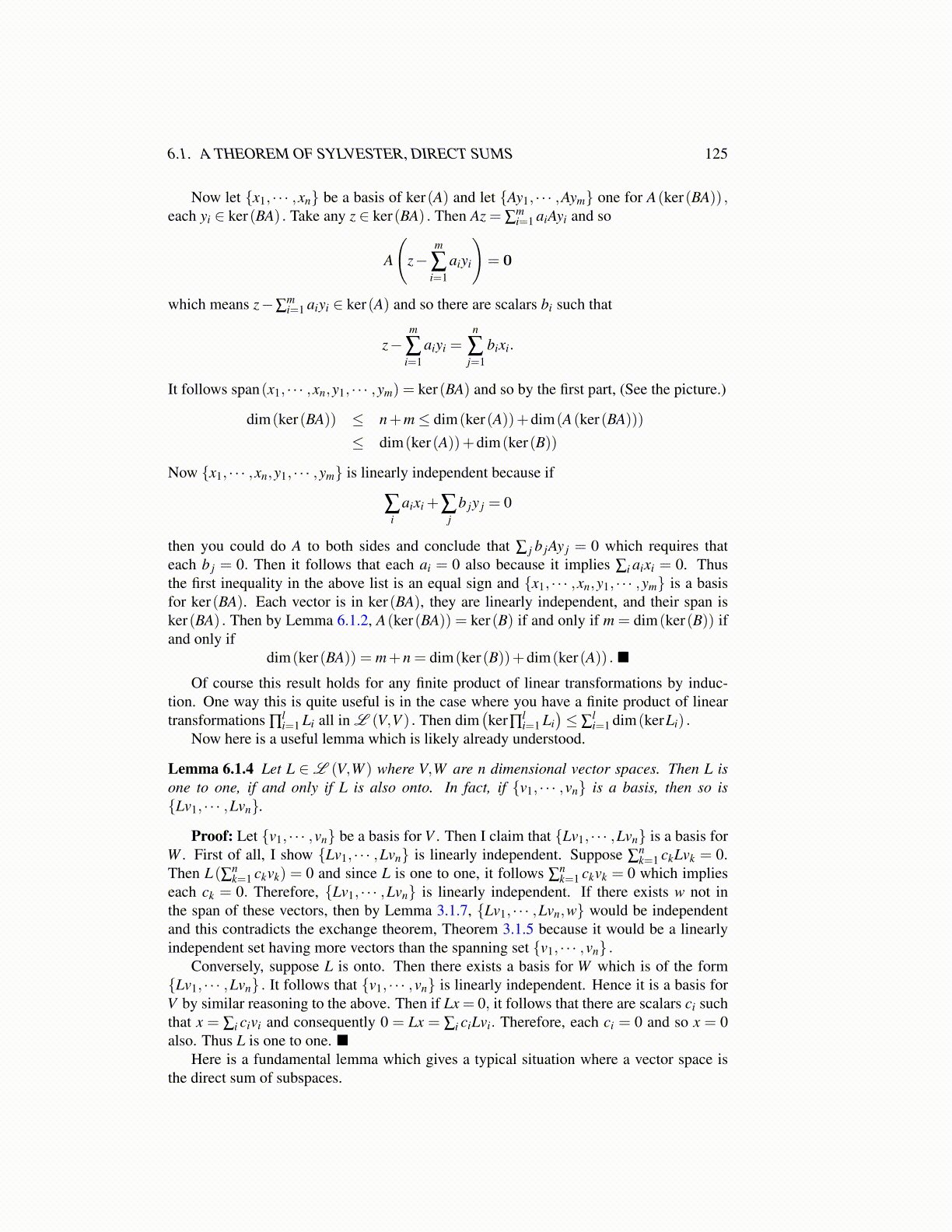
6.1. A THEOREM OF SYLVESTER, DIRECT SUMS 125
Now let {x1, · · · ,xn} be a basis of ker(A) and let {Ay1, · · · ,Aym} one for A(ker(BA)) ,each yi ∈ ker(BA) . Take any z ∈ ker(BA) . Then Az = ∑
mi=1 aiAyi and so
A
(z−
m
∑i=1
aiyi
)= 0
which means z−∑mi=1 aiyi ∈ ker(A) and so there are scalars bi such that
z−m
∑i=1
aiyi =n
∑j=1
bixi.
It follows span(x1, · · · ,xn,y1, · · · ,ym) = ker(BA) and so by the first part, (See the picture.)
dim(ker(BA)) ≤ n+m≤ dim(ker(A))+dim(A(ker(BA)))
≤ dim(ker(A))+dim(ker(B))
Now {x1, · · · ,xn,y1, · · · ,ym} is linearly independent because if
∑i
aixi +∑j
b jy j = 0
then you could do A to both sides and conclude that ∑ j b jAy j = 0 which requires thateach b j = 0. Then it follows that each ai = 0 also because it implies ∑i aixi = 0. Thusthe first inequality in the above list is an equal sign and {x1, · · · ,xn,y1, · · · ,ym} is a basisfor ker(BA). Each vector is in ker(BA), they are linearly independent, and their span isker(BA) . Then by Lemma 6.1.2, A(ker(BA)) = ker(B) if and only if m = dim(ker(B)) ifand only if
dim(ker(BA)) = m+n = dim(ker(B))+dim(ker(A)) . ■
Of course this result holds for any finite product of linear transformations by induc-tion. One way this is quite useful is in the case where you have a finite product of lineartransformations ∏
li=1 Li all in L (V,V ) . Then dim
(ker∏
li=1 Li
)≤ ∑
li=1 dim(kerLi) .
Now here is a useful lemma which is likely already understood.
Lemma 6.1.4 Let L ∈L (V,W ) where V,W are n dimensional vector spaces. Then L isone to one, if and only if L is also onto. In fact, if {v1, · · · ,vn} is a basis, then so is{Lv1, · · · ,Lvn}.
Proof: Let {v1, · · · ,vn} be a basis for V . Then I claim that {Lv1, · · · ,Lvn} is a basis forW . First of all, I show {Lv1, · · · ,Lvn} is linearly independent. Suppose ∑
nk=1 ckLvk = 0.
Then L(∑nk=1 ckvk) = 0 and since L is one to one, it follows ∑
nk=1 ckvk = 0 which implies
each ck = 0. Therefore, {Lv1, · · · ,Lvn} is linearly independent. If there exists w not inthe span of these vectors, then by Lemma 3.1.7, {Lv1, · · · ,Lvn,w} would be independentand this contradicts the exchange theorem, Theorem 3.1.5 because it would be a linearlyindependent set having more vectors than the spanning set {v1, · · · ,vn} .
Conversely, suppose L is onto. Then there exists a basis for W which is of the form{Lv1, · · · ,Lvn} . It follows that {v1, · · · ,vn} is linearly independent. Hence it is a basis forV by similar reasoning to the above. Then if Lx = 0, it follows that there are scalars ci suchthat x = ∑i civi and consequently 0 = Lx = ∑i ciLvi. Therefore, each ci = 0 and so x = 0also. Thus L is one to one. ■
Here is a fundamental lemma which gives a typical situation where a vector space isthe direct sum of subspaces.